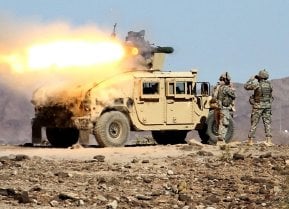TOW Missiles: America's Reliable Tank Buster Is a Super Killer
Made by Raytheon Systems, the TOW missile system is the de facto choice of anti-tank weaponry for the United States, NATO, UN Peacekeepers, and more.
Here's What You Need to Know: Raytheon has delivered more than 700,000 TOW weapon systems to the U.S. and allied forces, and upgrade programs could extend the missile's life cycle beyond 2050.
The BGM-71 TOW ("Tube-launched, Optically tracked, Wire-guided) anti-tank missile will remain in the U.S. Army's anti-tank arsenal through the mid-2030s. That is impressive given that the weapon system was first developed in the 1960s and has been in service since 1970.
The first generation of the TOW was used to bust North Vietnamese tanks in 1972—the first time ever that American troops fired an American-made missile under wartime conditions. Since then it has been the staple anti-tank guided missile on dozens of different vehicle platforms including the M2/M3 Bradley, COBRA helicopters, and the USMC's LAV-AT. It has been deployed to more than twenty international armed forces and has remained the preferred heavy assault anti-tank weapon system for NATO, coalition, United Nations, and peacekeeping forces around the globe.
Despite the fact that the weapon has been in service for fifty years, which is ancient by some military hardware standards, the TOW has gone through steady improvements since it was first developed by Hughes Aircraft Company. This has included an extended probe for greater standoff and penetration, along with an enhanced flight motor. In the late 1980s, the TOW 2 hardware improvements included a thermal beacon guidance system, while the 2A version gave the capability to defeat reactive armor.
The weapons system is now being produced by Raytheon Systems Company, which in 2010 upgraded the system to a wireless guidance system—thus changing the "W" in TOW from "wire-guided" to "wireless." In October 2015 the company also introduced the TOW EagleFire launcher, which could fire the wire-guided as well as wireless radio frequency missiles.
With these new improvements, the TOW has remained an effective and powerful anti-tank weapons platform.
"TOW gives soldiers the upper hand in battle," said Sam Deneke, Raytheon Land Warfare Systems vice president, via a statement announcing a $101 million U.S. Army contract for the TOW. "The system easily defeats opponents at long range in main battle tanks, fortified bunkers or moving armored vehicles."
The latest TOW 2A, TOW 2B Aero, and TOW Bunker Buster missiles can be fired from all TOW weapon system launchers—including the ITAS launcher, Stryker anti-tank guided missile vehicle (modified ITAS launcher) and Bradley Fighting Vehicles (Improved Bradley Acquisition Subsystem).
The next generation of launchers could also change the way a target is acquired. Whether wire-guided or wireless, a human operator is still required to optically track the TOW to the target—and this allows a trained gunner to have a manual override should the original target move or be mis-designated. The downside has always been that the human gunner would be exposed to enemy fire.
As Breaking Defense reported, Raytheon is developing a system that could still maintain human control but could feature an autonomous mode whereby a human gunner could designate the target, fire, and then take cover while the missile guides itself. Such a mode could offer the functionality of a fire-and-forget weapon with the accuracy that the TOW has always provided.
To date, Raytheon has delivered more than 700,000 TOW weapon systems to the U.S. and allied forces, and upgrade programs could extend the missile's life cycle beyond 2050.
Peter Suciu is a Michigan-based writer who has contributed to more than four dozen magazines, newspapers and website. He is the author of several books on military headgear including A Gallery of Military Headdress, which is available on Amazon.com.


